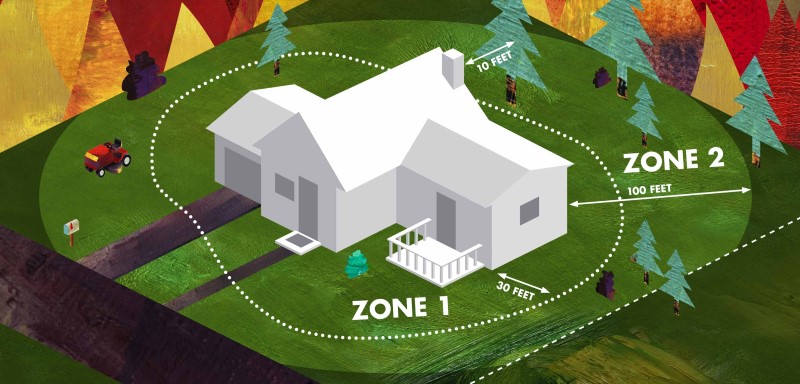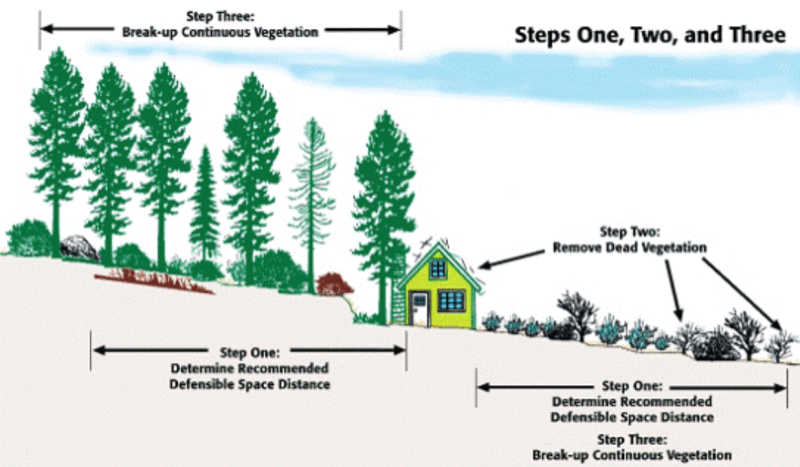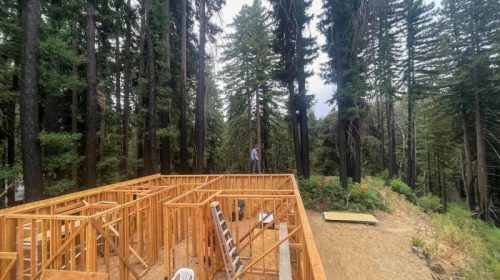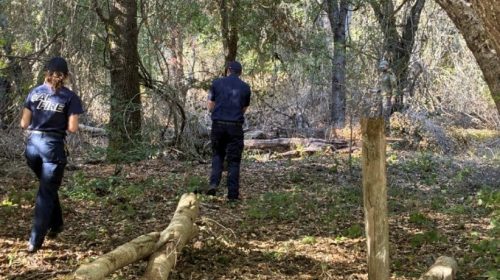SLV Homes: Defensible Space and Home Hardening
By M.C. Dwyer
Given the one year anniversary of the CZU Lightning Complex Fire, here’s a summary of the Santa Cruz Association of Realtors Fire Safety and Prevention Panel, presented by Mark Bingham, Boulder Creek Fire Chief; Mike Ayers, Ben Lomond Assistant Chief; Mike DeMars, Fire Marshall Central Fire District; and Greg Vandervoort, Fire Prevention Captain at Scotts Valley Fire Department; and a question-and-answer session with Steve Hawks, Staff Chief, California Department of Forestry and Fire Protection (Cal Fire). Both sessions focused on Defensible Space, Home Hardening, and Assembly Bill 38 (AB38).
Most of us adore living in nature, surrounded by trees rather than cities. Living in the urban/wildland interface isn’t new. Creating and maintaining a landscape that helps resist fire isn’t new either. Native Americans lived across California for centuries, managing the environment with controlled burns. And Cal Fire Defensible Space standards date back to the 1960s. Today, the backyard burning season is set by Cal Fire, by permit from Cal Fire or the Monterey Bay Air Resources District (MBARD.org). Panelists said backyard burns are a great way to reduce the fuel load on land.
Over the last hundred years, society emphasized fire suppression, and fuels built up. This situation is aggravated by what’s recently being labeled a megadrought – which has persisted for about 20 years. Evidence includes satellite imagery, towns sinking as aquifers go dry, and the shrinking of tree ring widths. The CZU fire exposed the somber reality of how truly dry our forests are: normally fires in redwood forests don’t burn like the CZU did. It’s become a local refrain that we’re safer now after the fire. These experts say it’s a misconception that another wildfire won’t happen. There’s a lot of weakened, damaged, and dead trees still standing, and those fallen still contain a lot of fuel.
During a wildfire, research shows that many house fires are started by flying embers, not direct flame spread. Wind carries burning embers to a roof or gutter, where dry leaves and needles act as tinder – easily catching fire. Embers can also ignite landscaping or wood siding, and even under a home if there’s an exposed post and pier foundation, flammable materials like lumber or gasoline stored under decks, or if the attic or foundation vent gaps are too wide. Ideal vents have 1/8th inch or smaller metal mesh, ideal roof materials include tile or metal.
Create Defensible Space
Maintaining defensible space reduces fire risk. Visit fire.ca.gov/dspace for more information. If using equipment that might spark, ideally work early in the morning when it’s cool, and preferably early in the year when it’s still moist.

Zone 1: In this inner 30’ circle, remove tree limbs near structures, and all dry or dead trees, branches, grasses and leaves. Move wood piles far away. Cal Fire diagrams show ideal heights between the ground and tree canopy, and spacing between trees, to minimize fire spread. Move flammable plants away from the house. Avoid resinous and woody plants including juniper, holly, pine trees, and wild lilac. Slope affects the equation: the CZU fire spread up trees on the neighbor’s hill behind my husband’s lost home, while barely grazing his gently sloped mowed fields, leaving a tenant’s truck untouched.
Zone 2: From 30’ to 100’ or farther, mow grasses to 4” or less. Adding vertical space and horizontal space between landscaping reduces fire spread. Remove dead landscape materials from the ground.
Zone 0: A new “zone zero” is still being defined…it may require minimizing landscaping and trees within 5’ of homes. If possible, move all trees and shrubs 5’ away, and clear fuels off the ground. Well-watered and maintained leafy plants without woody stems may be okay, but inflammable décor such as rock, pavers or flagstone is ideal. The panelists recommended against bark – previously many REALTOR’s go-to quick and inexpensive landscape fix.
What’s New for Real Estate?
Assembly Bill 38 (AB38) affects home sales. Many sellers are now required to give buyers a Home Fire Hardening Disclosure and Advisory if the property is in a High, or Very High severity zone (these are common in the Santa Cruz Mountains). As of July 1, sellers in these zones have six months to get their Certification of Compliance from a Defensible Space Inspection completed by the appropriate fire department – volunteer, city, or Cal Fire. Deficiencies are noted on the form, and you can schedule a reinspection after you’ve done the work. If the sale must close before the inspection or compliance is completed, the seller may transfer the responsibility to the buyer. The buyer then has up to one year to get that inspection completed and be compliant. Cal Fire and some jurisdictions can enforce compliance through court and fine processes. Cal Fire does the inspections in State Response Areas, and they work with local volunteer fire departments who also do property inspections. Note: properties are required to be maintained to these standards year-round. Fortunately, there is no cost for these inspections, and they only take about a week to schedule. Compliance provides enhanced safety and often results in the property looking better maintained.
Home Hardening goes hand in hand with defensible space. Homes built with permits after January 1, 2010 already are “hardened,” meaning the home’s fire resistance is improved through features including non-combustible or fire-resistant materials. Currently, there’s no law requiring retrofitting older homes to current home hardening building codes. Still, inspectors are happy to provide guidance.
It’s wise to be prepared, just in case. Are your “go bags” ready? Have you written and printed your evacuation packing list? No list? Remember the “Ps:” People, Pets, Prescriptions, Phone, Papers, Pictures, Personal computers, and Purse (wallet). Close your windows and leave as calmly as possible. Look after disabled or elderly neighbors, and know multiple routes out, in case one is blocked. Timely evacuation helps all first responders because their primary goal is life safety.
Examine your roads from the perspective of a fire crew; they need open, accessible roads with addresses visible through smoke. Work with neighbors to minimize limbs overhanging the road and cut back overgrown tunnels of vegetation so people can evacuate safely. Fire trucks need 10’ road width minimum with 15’ of vertical clearance or higher.
Resources
Code Red reverse 911 automatically calls people during emergencies. Sign up: scr911.org
ZoneHaven – Evacuation alerts. The zones have changed, know your zone! community.zonehaven.com
CAL Fire Defensible Space requirements fire.ca.gov/dspace
Fire Safe Santa Cruz County firesafesantacruz.org
Office of the State Fire Marshall osfm.fire.ca.gov
Cal Fire’s Prepare for Wildfire readyforwildfire.org
Questions about the housing market? Call, text, or e-mail me!
“M.C.” (MaryCatherine) Dwyer, MBA, REALTOR®
CA DRE License 01468388
EXP Realty of California, Inc.
Serving San Lorenzo Valley and Scotts Valley since 2005
(831) 419-9759 E-mail: mcd@mcdwyer.com
The statements and opinions contained in this article are solely those of the individual author and do not necessarily reflect the positions or opinions of eXp Realty, LLC, or its subsidiaries or affiliates (the “Company”). The Company does not assume any responsibility for, nor does it warrant the accuracy, completeness or quality of the information provided.
Photo captions
Featured image of Home Hardening from geodisclosure.com
The San Lorenzo Valley Post is your essential guide to life in the Santa Cruz Mountains. We're dedicated to delivering the latest news, events, and stories that matter to our community. From local government to schools, from environmental issues to the arts, we're committed to providing comprehensive and unbiased coverage. We believe in the power of community journalism and strive to be a platform for diverse voices.





